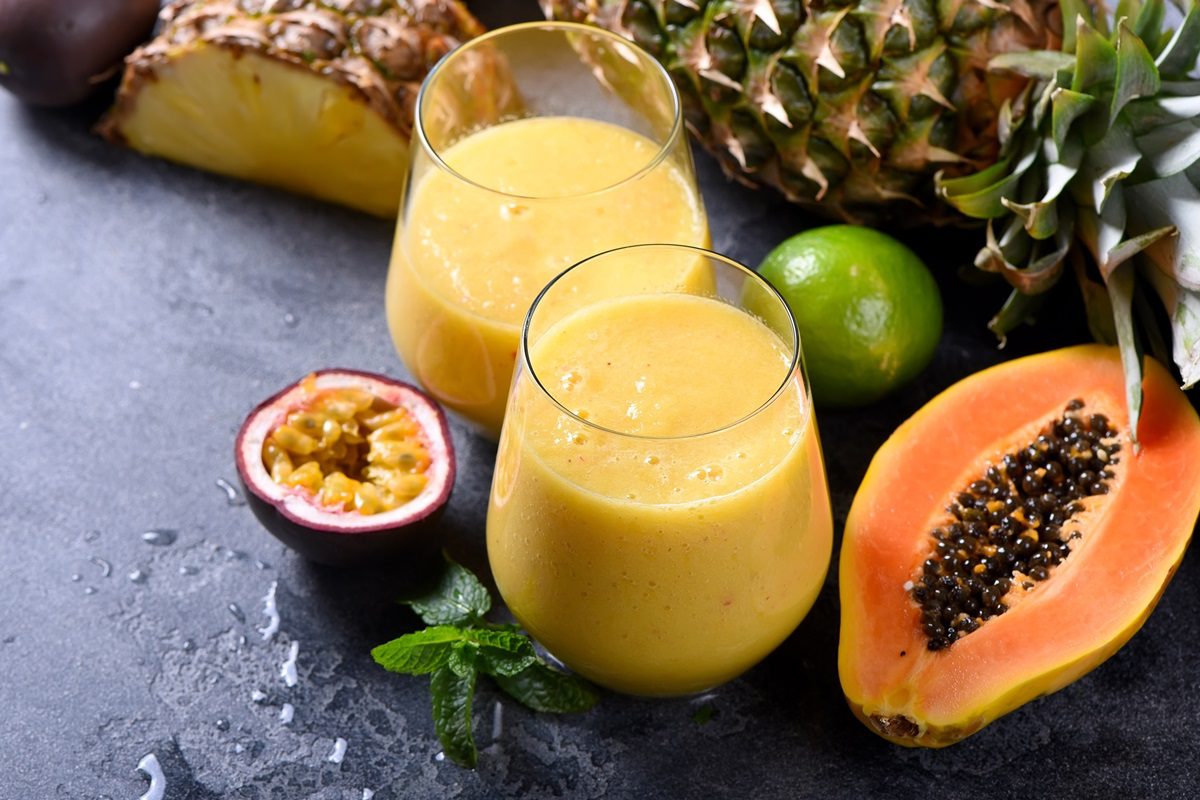Tropical smoothies offer a refreshing escape into a world of exotic flavors and health benefits. From the enticing blend of fruits to the nutritional boost they provide, these vibrant concoctions have become a staple for health enthusiasts and flavor smoothie aficionados alike.
Understanding Tropical Smoothies
What Defines a Tropical Smoothie?
- Tropical Fruits: Mangoes, pineapples, bananas, papayas, and coconuts form the core of tropical smoothies, infusing them with rich, exotic flavors.
- Nutritional Profile: Each fruit contributes a unique set of vitamins, minerals, and antioxidants, enhancing the smoothie’s health quotient.
- Enhancements: Additions like yogurt, coconut water, or nut milk elevate these blends’ texture and nutritional value.
The Health Benefits of Tropical Smoothies
Nutritional Advantages
- Vitamins and Antioxidants: Tropical fruits are powerhouses of vitamins A, C, and E, bolstering the immune system and promoting skin health.
- Digestive Health: Enzymes in these fruits aid digestion, while fiber content supports a healthy gut.
- Hydration and Electrolytes: Coconut water, a common ingredient, replenishes electrolytes and keeps the body hydrated.
Crafting the Perfect Tropical Smoothie
Recipe Ideas
- Tropical Sunrise Blend: Combine mango, pineapple, and coconut water for a refreshing start to your day.
- Island Breeze Fusion: Blend banana, papaya, and orange juice for a tangy twist.
- Tropical Green Goddess: Mix spinach, kale, mango, and coconut milk for a nutritious, green-packed smoothie.
Tips for Blending
- Frozen vs Fresh Fruits: Frozen fruits can enhance the smoothie’s texture without diluting the flavors.
- Balancing Sweetness: Adjust sweetness by adding honey, agave nectar, or dates for natural sweetness instead of refined sugars.
- Protein Boost: Incorporate protein sources like Greek yogurt, tofu, or protein powder for a more satiating blend.
Tropical Smoothie Trends and Innovations
Evolution in Ingredients
- Superfood Additions: Ingredients like chia seeds, acai, or turmeric are gaining popularity for their added health benefits.
- Plant-Based Options: Catering to diverse dietary preferences, plant-based protein sources, and dairy alternatives are becoming more prevalent.
Sustainable Practices in Smoothie Making
- Local Sourcing: Embracing locally sourced fruits and eco-friendly packaging to reduce carbon footprints.
- Waste Reduction: Innovative methods to repurpose fruit peels and excess ingredients, minimizing waste in the production process.
Enhancing the Tropical Smoothie Experience
Pairings and Complements
- Granola and Nuts: Adding a crunch with granola or nuts can elevate the smoothie’s texture and provide extra nutrients.
- Fresh Garnishes: Sprigs of mint, slices of citrus fruits, or coconut shavings can enhance visual appeal and flavor.
Serving Suggestions
- Glassware Matters: Opt for transparent glasses to showcase the vibrant colors of the smoothie.
- Temperature Considerations: Serve chilled for a refreshing experience, or try variations like frozen smoothie bowls for added texture.
The Future of Tropical Smoothies in the Culinary Landscape
Innovations on the Horizon
- Personalized Blending: Advancements in technology may lead to customizable smoothie-making machines catering to individual preferences.
- Nutritional Insights: Integration of apps or devices providing real-time nutritional information for customizing smoothie recipes.
Global Influence and Fusion
- Cultural Blending: Fusion of tropical flavors with global cuisines, creating unique, cross-cultural smoothie experiences.
- Health and Wellness Integration: Further incorporating functional ingredients catering to specific health needs and dietary requirements.
Frequently Asked Questions about Tropical Smoothies
Q. What Makes Tropical Smoothies Different?
A. Tropical smoothies stand out because they use exotic fruits like mangoes, pineapples, and coconuts, creating a unique taste profile.
Q. Are Tropical Smoothies Nutritious?
A. Absolutely! Packed with vitamins, antioxidants, and fiber, these smoothies offer a healthy dose of nutrition.
Q. Can I Customize My Tropical Smoothie?
A. Yes, customization is key! Experiment with different fruits, add-ons like protein powder or greens, and varied liquid bases to suit your taste and health preferences.
Q. Are There Any Allergy Concerns with Tropical Smoothies?
A. While rare, some tropical fruits like mangoes can trigger allergies in sensitive individuals. When trying new ingredients, it’s essential to be mindful of any known allergies.
Q. Can I Include Tropical Smoothies in a Weight Loss Plan?
A. When consumed mindfully, tropical smoothies can be a part of a level diet for weight control. Controlling portion sizes and avoiding excessive added sugars are key considerations.
Q. How Should I Store Tropical Smoothies?
A. Ideally, consume freshly made smoothies for optimal taste and nutritional value. An airtight receptacle in the refrigerator for 24 hours is recommended if stored.
Q. What’s the Best Time to Enjoy a Tropical Smoothie?
A. There’s no specific “best” time! They can serve as a nutritious breakfast, a refreshing post-workout drink, or a mid-day snack.
Q. Are Tropical Smoothies Suitable for Children?
A. Absolutely! Kids tend to love the vibrant colors and sweet flavors of tropical smoothies. Just ensure any ingredients are age-appropriate and consider portion sizes.
Q. Can Tropical Smoothies Help with Skin Health?
A. Yes, tropical fruits’ vitamin C and antioxidants can donate to healthier skin by stimulating collagen production and fighting free radicals.
Q. How Can I Enhance the Creaminess of a Tropical Smoothie?
A. Adding ingredients like Greek yogurt, avocado, or frozen bananas can elevate the creaminess and texture of the smoothie.











